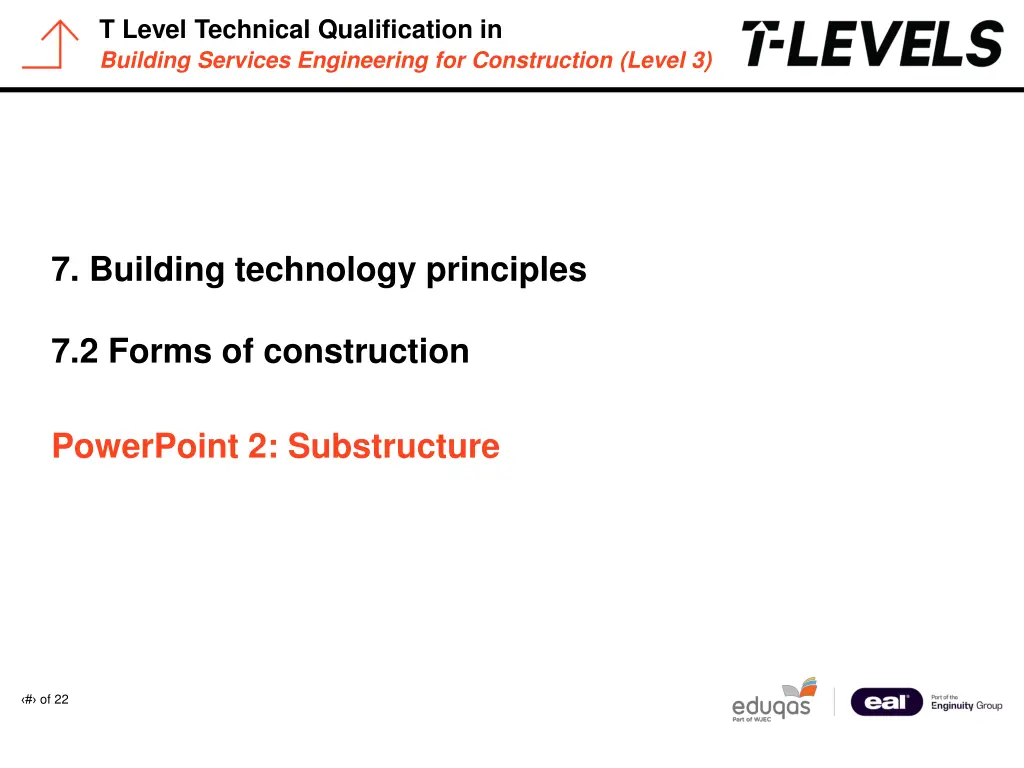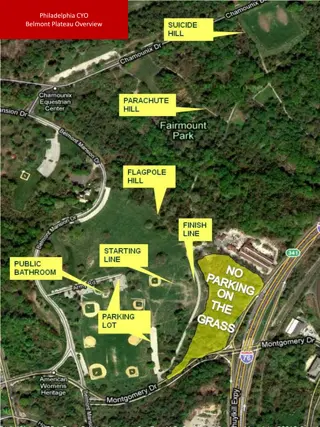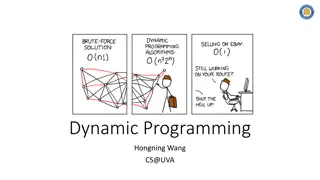
Building Services Engineering Concepts
Explore the key principles of building technology, including substructure elements like foundations, basements, and retaining walls. Learn how site investigations play a crucial role in the construction process. Discover the importance of substructures in transferring loads and ensuring building stability.
Download Presentation

Please find below an Image/Link to download the presentation.
The content on the website is provided AS IS for your information and personal use only. It may not be sold, licensed, or shared on other websites without obtaining consent from the author. If you encounter any issues during the download, it is possible that the publisher has removed the file from their server.
You are allowed to download the files provided on this website for personal or commercial use, subject to the condition that they are used lawfully. All files are the property of their respective owners.
The content on the website is provided AS IS for your information and personal use only. It may not be sold, licensed, or shared on other websites without obtaining consent from the author.
E N D
Presentation Transcript
T Level Technical Qualification in Building Services Engineering for Construction (Level 3) PowerPoi nt sentation 7. Building technology principles 7.2 Forms of construction PowerPoint 2: Substructure # of 22
T Level Technical Qualification in Building Services Engineering for Construction (Level 3) Substructure All buildings start with the substructure. This is all the structure below ground, up to and including the damp proof course (DPC). The purpose of the substructure is to receive the loads from the superstructure and transfer them safely down to a suitable load-bearing layer of ground. Elements of the substructure: foundations basements retaining walls. # of 22
T Level Technical Qualification in Building Services Engineering for Construction (Level 3) Foundations The foundations are the main element of a substructure. They ensure that all dead and imposed loads are safely transmitted through to the subsoils on which the building is constructed. Failure to adequately transmit the loads and select a suitable type of foundation will result in the stability of the building being compromised and, potentially, structural damage. # of 22
T Level Technical Qualification in Building Services Engineering for Construction (Level 3) Basements A basement is a part of a building, either partially or completely below ground. Basements are not often incorporated into new developments but are more popular in areas where there is a high demand for living and the cost of land is high. In areas such as London, residents are converting and creating basements to provide extra liveable space. Legislative constraints are a big consideration. Advantages Floor area Space Privacy Sloping sites Disadvantages Waterproofing Drainage Ventilation Natural light # of 22
T Level Technical Qualification in Building Services Engineering for Construction (Level 3) Retaining walls Retaining walls are vertical structures designed to retain a material on one side most commonly soil. Retaining walls can be incorporated into a building s design or be part of a landscaping design. # of 22
T Level Technical Qualification in Building Services Engineering for Construction (Level 3) Site investigations In the early stages of the design process, site investigations should be carried out to gather information on the proposed site. The data that will need to be collected includes: position of boundary fences and hedges location of underground services including gas, water, electricity and drains existing buildings that need to be demolished or protected position, height, girth and spread of any trees on the site boundary types and properties of the soil. # of 22
T Level Technical Qualification in Building Services Engineering for Construction (Level 3) Soil investigations Subsoils can be many different types and have different load-bearing capacities. Soil investigations must be carried out to identify the type and properties of the soil so an appropriate type of foundation can be selected. Soil type Rock Granite Loose sand Peat Chalk Compact sand Silt Soft clay Bearing capacity High High Low Low High High Low Low # of 22
T Level Technical Qualification in Building Services Engineering for Construction (Level 3) Site clearance This is the process of removing existing buildings, waste, vegetation and topsoil. It is not suitable to build on topsoil as the surface layer is difficult to compact down and it contains various chemicals that promote plant growth. The process of removing topsoil can be costly and requires prior consideration in terms of transportation and labour. During the site investigations the site engineer will determine the volume of soil that requires removal. Some sites may have storage areas or garden plots available. If this is not the case then storage and transportation must be planned. # of 22
T Level Technical Qualification in Building Services Engineering for Construction (Level 3) Foundations in detail: trench excavation In modern construction, trenches will generally be excavated using mechanical aids rather than manual labour. Using machines results in higher costs due to the equipment required but reduces the amount of labour and time spent on the excavation work. For small building extensions or where accessibility is poor, manual excavation may be the most appropriate method. # of 22
T Level Technical Qualification in Building Services Engineering for Construction (Level 3) Trench support Trench support prevents trenches from collapsing in on themselves. The types and extent of the support will depend on the depth of the trench and the subsoil stability. In modern construction it is common for steel rails and sheeting to be used rather than traditional materials such as timber. A mixture of materials may be appropriate depending on the characteristics of the soil. Site engineers will make calculations to identify the appropriate support requirements for trenches. # of 22
T Level Technical Qualification in Building Services Engineering for Construction (Level 3) Selecting the right foundations Consider: the ground conditions the soil type any loads that may be generated either by the structure or naturally the location of drains and trees in relation to the proposed building. # of 22
T Level Technical Qualification in Building Services Engineering for Construction (Level 3) Strip foundations Strip foundations are a common choice of foundation for use in low-rise residential construction up to three storeys. The concrete strip spreads the load of the heavy walls. The width of the strip depends on the load of the building and the bearing capacity of the soil. There are two main types of strip foundation: narrow strip wide strip. # of 22
T Level Technical Qualification in Building Services Engineering for Construction (Level 3) Narrow and wide strip foundations Narrow and wide strip foundations are two common types of shallow foundations used in construction, each suited to different structural and soil conditions. Narrow strip foundations are typically used for light-load-bearing walls and structures where the soil has good bearing capacity. They consist of a continuous strip of concrete under load-bearing walls, with a width just enough to safely distribute the load. In contrast, wide strip foundations are employed when the soil has a lower bearing capacity or when the building loads are heavier. These foundations are broader, spreading the load over a larger area to prevent excessive settlement. The choice between narrow and wide strip foundations depends on factors such as soil type, building load, and construction budget, with wide strips offering greater stability at a higher material cost. # of 22
T Level Technical Qualification in Building Services Engineering for Construction (Level 3) Raft foundations Theseare commonly used on soils with poor bearing capacity or where subsidence is likely to occur. Raft foundations can withstand small settlements in the soil and act by spreading the load over the entire area of the ground floor of a building. # of 22
T Level Technical Qualification in Building Services Engineering for Construction (Level 3) Pad foundations These are commonly used on large purpose-built structures such as industrial units or commercial buildings to support large, roofed structures. Pad foundations are rectangular or circular pads used to support localised loads such as columns. # of 22
T Level Technical Qualification in Building Services Engineering for Construction (Level 3) Other foundation types Pile foundations are typically used for large structures and where poor soil will not prevent excess settlement. They transfer the load of a building to a much deeper subsoil that has a higher bearing capacity. Driven piles can be driven into the ground using either a vibration driver or a pile driver. This method can be disruptive to surrounding areas and residents as it involves hammering the pile into the ground. Bored piles: a cylindrical hole is bored using a large auger and is then filled with concrete. Often these piles are reinforced with a metal cage before pouring the concrete. # of 22
T Level Technical Qualification in Building Services Engineering for Construction (Level 3) Foundation reinforcement Concrete is a prime element used in the formation of foundations. As a material, concrete has a high compressive strength but is weak in tension. Steel reinforcement can be incorporated into the foundation design to provide extra strength and avoid cracks occurring in the foundations. # of 22
T Level Technical Qualification in Building Services Engineering for Construction (Level 3) Any questions? # of 22













